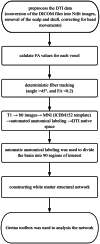Intractable prefrontal and limbic white matter network disruption in adolescents with drug-naïve nonsuicidal self-injury
- PMID: 40597916
- PMCID: PMC12219605
- DOI: 10.1186/s12888-025-07106-6
Intractable prefrontal and limbic white matter network disruption in adolescents with drug-naïve nonsuicidal self-injury
Abstract
Background: The white matter network changes that accompany nonsuicidal self-injury (NSSI) among adolescents are not well understood. This study thus sought to investigate the structural connectivity and network features of adolescents with drug-naïve NSSI, while also evaluating the alterations in these parameters following treatment.
Method: The diffusion tensor imaging and clinical scales were used to evaluate 43 adolescents with drug-naïve NSSI, 20 of them after treatment (post-treatment NSSI group), and 43 healthy controls (HC). Graph theory analyses were used to construct a white matter network consisting of 90 regions for these participants. Network-based statistic (NBS) correction methods were used to assess structural connectivity within this network, and a generalized linear model was used to compare network metrics between NSSI and HCs, whereas paired t-tests were used to compare the same patients pre- and post-treatment. Correlations between clinical symptoms and both structural connectivity and network metrics were assessed.
Results: Greater structural connectivity was observed between the right caudate nucleus and right olfactory cortex, right superior frontal gyrus (medial orbital), and right amygdala in adolescents with drug-naïve NSSI relative to HCs. Adolescents with drug-naïve NSSI was also found with increased characteristic path length and normalized characteristic path length values in network metrics, and reduced global efficiency and nodal network metrics for the right orbital middle frontal gyrus, which were also negatively correlated with anxiety and self-injury symptoms. After treatment, post-treatment NSSI group exhibited network alterations that were most pronounced in the prefrontal lobes, left parahippocampal gyrus, and left middle occipital gyrus.
Conclusions: These results offer new insight into the abnormal structural connectivity and network metrics that arise in the prefrontal gyrus and limbic system of adolescents with drug-naïve NSSI, potentially providing guidance for the interpretation of NSSI-related imaging changes in the white matter network.
Keywords: Adolescent; Diffusion tensor imaging; Emotional regulation; Nonsuicidal self-injury; Structural connectivity; White matter.
© 2025. The Author(s).
Conflict of interest statement
Declarations. Ethical approval and consent to participate: This study complied with the content and requirements of the Helsinki Declaration and was reviewed and approved by the Medical Ethics Committee of the Affiliated Hospital of North Sichuan Medical College (2022ER406-1), with all participants and legal guardians having provided written informed consent before participating. Consent for publication: Not applicable. Competing interests: The authors declare no competing interests.
Figures




References
-
- Butler AM, Malone K. Attempted suicide v. non-suicidal self-injury: behaviour, syndrome or diagnosis? Br J Psychiatry: J Mental Sci. 2013;202(5):324–5. - PubMed
-
- Wilkinson P, Kelvin R, Roberts C, Dubicka B, Goodyer I. Clinical and psychosocial predictors of suicide attempts and nonsuicidal self-injury in the adolescent depression antidepressants and psychotherapy trial (ADAPT). Am J Psychiatry. 2011;168(5):495–501. - PubMed
-
- Bresin K, Schoenleber M. Gender differences in the prevalence of nonsuicidal self-injury: A meta-analysis. CLIN PSYCHOL REV. 2015;38:55–64. - PubMed
-
- Swannell SV, Martin GE, Page A, Hasking P, St John NJ. Prevalence of nonsuicidal self-injury in nonclinical samples: systematic review, meta-analysis and meta-regression. Suicide Life-Threat Behav. 2014;44(3):273–303. - PubMed
MeSH terms
Grants and funding
LinkOut - more resources
Full Text Sources
Medical
Research Materials
Miscellaneous

